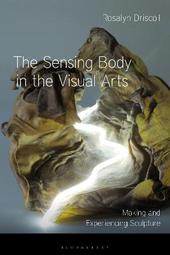
|
The Sensing Body in the Visual Arts: Making and Experiencing Sculpture
Hardback
Main Details
| Title |
The Sensing Body in the Visual Arts: Making and Experiencing Sculpture
|
| Authors and Contributors |
By (author) Rosalyn Driscoll
|
| Physical Properties |
| Format:Hardback | | Pages:232 | | Dimensions(mm): Height 234,Width 156 |
|
| Category/Genre | Theory of art
Sculpture
Museum, historic sites, gallery and art guides |
|---|
| ISBN/Barcode |
9781350122222
|
| Classifications | Dewey:730.11 |
|---|
| Audience | | Professional & Vocational | |
|---|
| Illustrations |
28 bw illus
|
|
Publishing Details |
| Publisher |
Bloomsbury Publishing PLC
|
| Imprint |
Bloomsbury Visual Arts
|
| Publication Date |
17 September 2020 |
| Publication Country |
United Kingdom
|
Description
This book provides original grounds for integrating the bodily, somatic senses into our understanding of how we make and engage with visual art. Rosalyn Driscoll, a visual artist who spent years making tactile, haptic sculpture, shows how touch can deepen what we know through seeing, and even serve as a genuine alternative to sight. Driscoll explores the basic elements of the somatic senses, investigating the differences between touch and sight, the reciprocal nature of touch, and the centrality of motion and emotion. Awareness of the somatic senses offers rich aesthetic and perceptual possibilities for art making and appreciation, which will be of use for students of fine art, museum studies, art history and sensory studies.
Author Biography
Rosalyn Driscoll is an independent visual artist and scholar. Her work has been exhibited in the US, Europe and Asia, for which she has won numerous awards. Driscoll was an acting director at Brattleboro Museum and Art Centre from 1985-1990.
ReviewsThe Sensing Body in the Visual Arts begins with the sculptor asking a simple question: what would it be like for someone to experience the work of art through touch alone? This takes her, and her reader, on a complex exploration of sensory perception and aesthetics. Touch, as Driscoll reveals, involves far more than the simple recognition of forms through tracing their outline, or the simple appreciation of different textures. A fully embodied experience of art links the intellect with the emotions, and intertwines time, space and movement. The book boldly challenges conventions of art criticism and museum display practices. It is a compelling read for anyone interested in art, with much to say to cognitive science, aesthetic philosophy, art criticism and museology. * Georgina Kleege, author of More Than Meets the Eye: What Blindness Brings to Art (2018) *
|